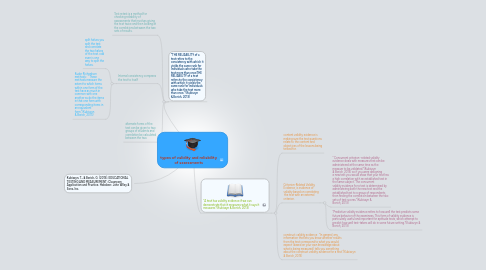
1. "THE RELIABILITY of a test refers to the consistency with which it yields the same rank for individuals who take the test more than onceTHE RELIABILITY of a test refers to the consistency with which it yields the same rank for individuals who take the test more than once."(Kubiszyn & Borich, 2013)
1.1. Test retest is a method for checking reliability of assessments that involves giving the test twice and then looking at the correlations between the two sets of results.
1.2. Internal consistency compares the test to itself
1.2.1. split halves you split the test and correlate the two halves of the test. odd even is one way to split the halves.
1.2.2. Kudor Richardson methods : " These methods measure the extent to which items within one form of the test have as much in common with one another as do the items in that one form with corresponding items in an equivalent form."(Kubiszyn & Borich, 2013)
1.3. alternate forms of the test can be given to two groups of students and correlation be calculated between the two.
2. Kubiszyn, T., & Borich, G. (2013). EDUCATIONAL TESTING AND MEASUREMENT: Classroom Application and Practice. Hoboken: John Wiley & Sons, Inc.
3. "A test has validity evidence if we can demonstrate that it measures what it says it measures"(Kubiszyn & Borich, 2013)
3.1. content validity evidence is making sure the test questions relate to the content and objectives of the lessons being tested for.
3.2. Criterion-Related Validity Evidence, is evidence of validity based on correlating the test with an external criterion.
3.2.1. " Concurrent criterion- related validity evidence deals with measures that can be administered at the same time as the measure to be validated."(Kubiszyn & Borich, 2013) so if you were designing a new test you would show that your test has a high correlation with an established test in the same subject."The concurrent validity evidence for a test is determined by administering both the new test and the established test to a group of respondents, then finding the correlation between the two sets of test scores."(Kubiszyn & Borich, 2013)
3.2.2. "Predictive validity evidence refers to how well the test predicts some future behavior of the examinees. This form of validity evidence is particularly useful and important for aptitude tests, which attempt to predict how well test-takers will do in some future setting."(Kubiszyn & Borich, 2013)
